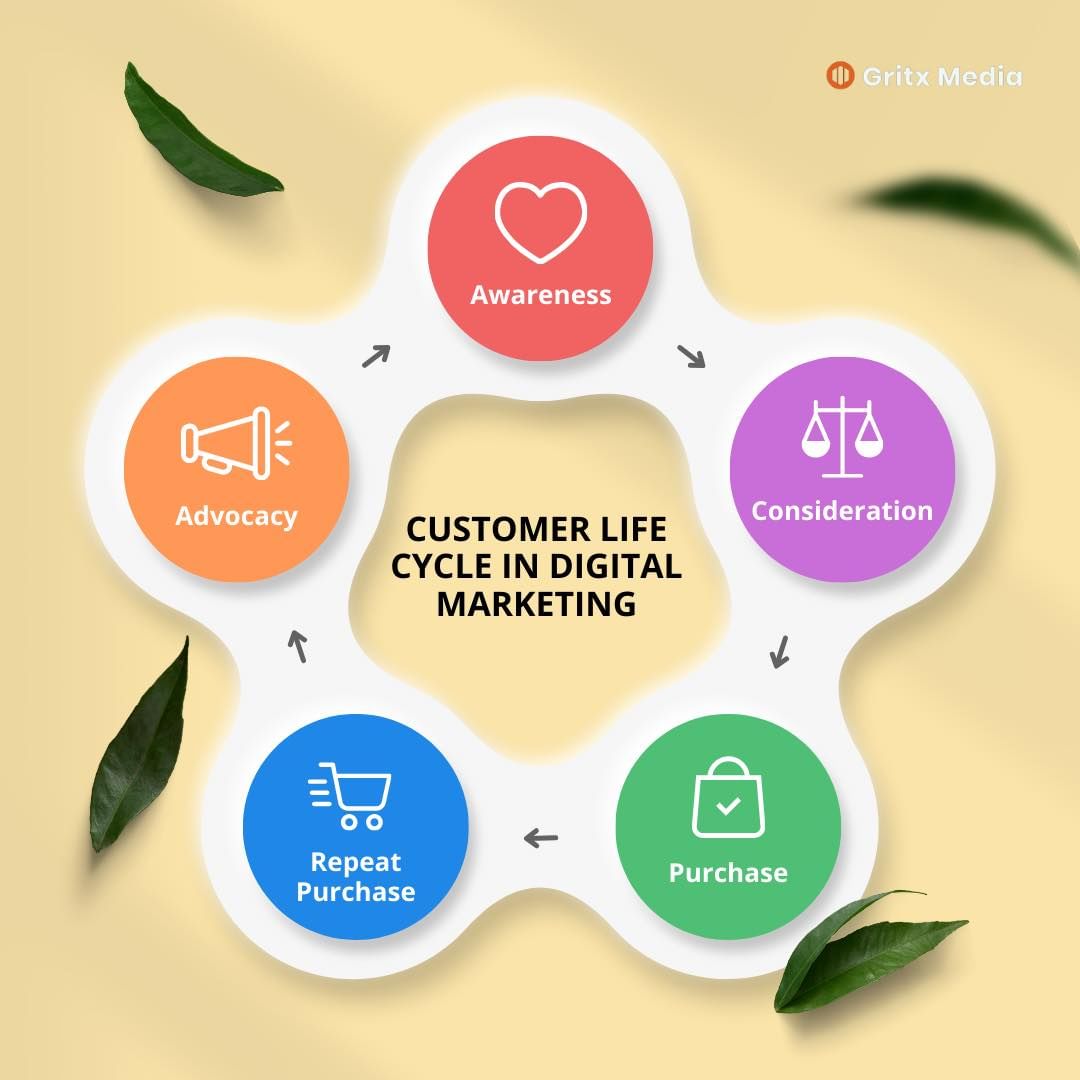In today’s digital age, understanding and effectively navigating the customer lifecycle is essential for businesses seeking to build meaningful and long-lasting relationships with their audience. From initial awareness to advocacy, each stage presents unique opportunities for engagement and conversion. Let’s explore the five stages of the customer lifecycle in digital marketing and strategies to maximize success at each step.

Stage 1: Awareness
The awareness stage marks the beginning of the customer journey, where potential customers become aware of your brand, products, or services. In this stage, your goal is to capture the attention of your target audience and make a memorable impression. Strategies for building awareness include:
- Content Marketing: Create informative and engaging content that addresses the needs and interests of your target audience. Utilize blog posts, videos, infographics, and social media to showcase your expertise and attract attention.
- Search Engine Optimization (SEO): Optimize your website and content for relevant keywords to improve visibility in search engine results. By appearing at the top of search engine rankings, you increase the likelihood of being discovered by potential customers.
- Social Media Marketing: Leverage social media platforms to connect with your audience and promote your brand. Engage in conversations, share valuable content, and interact with followers to increase brand awareness and foster a sense of community.
Stage 2: Consideration
Once potential customers are aware of your brand, they enter the consideration stage, where they evaluate their options and weigh the benefits of different solutions. Your objective during this stage is to build trust and credibility while guiding prospects towards making a purchase decision. Key strategies for consideration include:
- Email Marketing: Nurture leads with targeted email campaigns that provide valuable information and resources. Segment your email list based on interests and behaviors to deliver personalized content that resonates with each prospect.
- Educational Content: Offer in-depth guides, case studies, and product demonstrations to help prospects understand the value proposition of your offerings. Position your brand as a trusted advisor and industry expert by providing valuable insights and solutions.
- Customer Testimonials: Showcase satisfied customers and client success stories to demonstrate the effectiveness of your products or services. Authentic testimonials and reviews help build social proof and instill confidence in potential buyers.
Stage 3: Purchase
The purchase stage is where prospects transition into paying customers, completing a transaction and making a commitment to your brand. Your focus at this stage is to streamline the buying process and provide a seamless experience that encourages conversion. Strategies for facilitating purchases include:
- Optimized Conversion Funnel: Simplify the checkout process and remove any barriers that may prevent customers from completing their purchase. Optimize your website for speed and mobile responsiveness to ensure a smooth user experience.
- Promotions and Discounts: Offer incentives such as discounts, free shipping, or limited-time offers to incentivize purchases and drive conversions. Use targeted promotions to encourage action and create a sense of urgency.
- Remarketing Campaigns: Implement remarketing campaigns to re-engage visitors who have shown interest in your products but have not yet made a purchase. Display targeted ads across various channels to remind prospects of your offerings and encourage them to return and complete their purchase.
Stage 4: Repeat Purchase
Customer retention is key to long-term success, and the repeat purchase stage focuses on encouraging existing customers to make additional purchases and become loyal advocates for your brand. Strategies for fostering repeat purchases include:
- Loyalty Programs: Reward loyal customers with exclusive perks, discounts, and rewards for their continued patronage. Implement a tiered loyalty program that incentivizes customers to spend more and unlock greater benefits.
- Personalized Recommendations: Use data-driven insights to deliver personalized product recommendations and offers based on past purchase behavior and preferences. Tailor your messaging to each customer’s unique needs and interests to enhance relevance and encourage repeat purchases.
- Exceptional Customer Service: Provide exceptional customer service and support to ensure a positive shopping experience. Address customer inquiries promptly, resolve issues efficiently, and go above and beyond to exceed expectations. Happy customers are more likely to become repeat buyers and brand advocates.
Stage 5: Advocacy
In the advocacy stage, satisfied customers become brand advocates, sharing their positive experiences and recommending your products or services to others. Harnessing the power of advocacy is essential for driving word-of-mouth referrals and building a loyal customer base. Strategies for encouraging advocacy include:
- Customer Referral Programs: Encourage satisfied customers to refer their friends and family members to your business by offering incentives such as discounts, rewards, or exclusive perks for successful referrals.
- User-Generated Content: Encourage customers to create and share user-generated content, such as testimonials, reviews, and social media posts showcasing their experiences with your brand. User-generated content adds authenticity and credibility to your marketing efforts.
- Engage with Advocates: Show appreciation for your brand advocates by acknowledging their support and engaging with them on social media and other channels. Share their content, respond to their comments, and involve them in special events or promotions to strengthen the relationship and encourage continued advocacy.
Navigating the digital customer journey requires a strategic approach that addresses each stage of the customer lifecycle. By implementing targeted strategies for awareness, consideration, purchase, repeat purchase, and advocacy, businesses can attract, engage, and retain customers while driving long-term success and growth. Understanding the needs and preferences of your audience and delivering value at every touchpoint helps you create meaningful relationships that stand the test of time.
